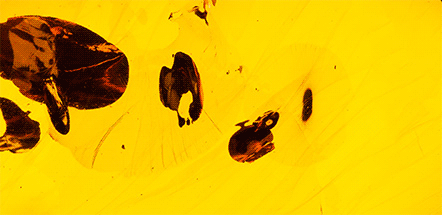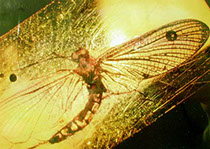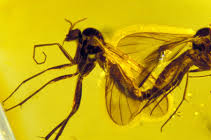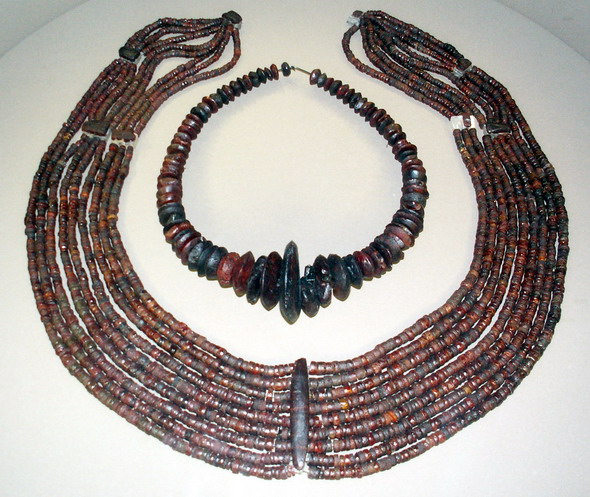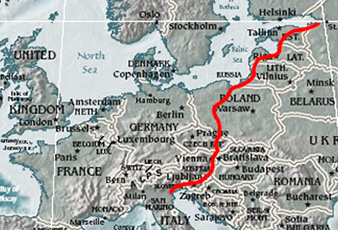
The word „Amber“ names the opaque yellow gem stone from fossil resin known for millenniums.
The oldest known amber comes from about 310 million year old coals. The resin of trees at that time has been preserved as a firm substance.
Already since prehistoric times amber is used as a jewellery and for objects of art. Some objects found in Egypt are more than 6000 years old.
The Ancient Greek word for amber is ḗlektron (ἤλεκτρον) which can be translated with "bright gold". The Romans called amber with the Greek foreign word electrum or called it succinum (probably after succus, thick liquid, juice) in the right assumption, it has originated of tree juice.
In the Arabian amber is called anbar; out of this the today's name is derived for amber into some languages (e.g., engl.: amber; frz.: ambre jaune; span. el ámbar; ital. ambra).
For a long time the name Amber is used as a collective term for all firm particles to form fossil resins.
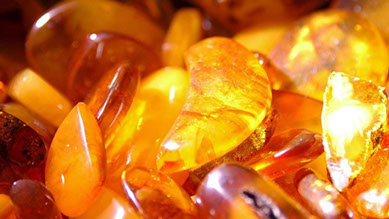
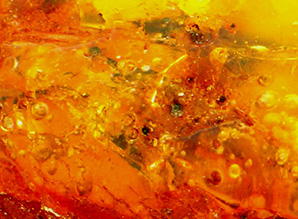

Inclusions The excellently preserved inclusions in the amber release admiration over and over again. In particular the inclusions of softly winged insects fascinate by their finest details with full-physical preservation. They are neither crushed nor otherwise deformed.
Pieces with completely preserved reports of the life at that time are especially valuable from scientific view. These inclusions are fossils of small animals or plant parts, in rare cases, even fabric leftovers whose imprints (indentation) are perfectly preserved, in amber for millions of years.
Inclusions are to be seen generally only in clear or at least half-clear pieces. The life forms preserved in amber have been predominantly forest inhabitants.
Specific features The colour of amber reaches from colorless about white, pale yellow to golden brown and orange up to red tones and brown tones, with clouded pieces, greenish and bluish tones can also appear by light breaking effects. Deep brown to black-grey pieces contain larger amounts of herbal and mineral inclusions.
The „cloudiness degree“ depends on the number of microscopic small vesicles.
Amber has a very high electric resistance. In dry surroundings it can be charged electrostatically by rubbing against fabric (cotton, silk) or wool.
This feature can be used as an „non destructive“ proof of genuineness – although with smaller pieces it can be tricky.
The charged amber draws small paper scraps, material fibers or woollen fluff.
This effect was already known in ancient times and was passed down by the works of Plinius the Elder. Also the Greek philosopher Aristotelis reports about that.
Amber shines when in not weathered or freshly cut state, under UV light blue and in weather-beaten state in a matt olive green.
back
Proof of genuineness In order to check whether an amber is an original or an imitat, a glowing needle can be used. It is held to the stone and pulled with some pressure over it. If a groove forms and the stone starts to get greasy or smells resinously, while the needle remains at a place, it is an amber. Otherwise it is an imitat.
Alternatively the density can be used to test amber. Amber sinks in fresh water (e.g., to normal tap water), nevertheless, swims in concentrated salted water. Use two vessels, one with fresh water, one with salted water (about two tablespoons salt on a quarter litre water). Amber sinks into the first glass, nevertheless, swims in the second one. Plastic also swims on fresh water, stones and glass sink into the salted water.
To check the genuineness of amber the fluorescence method is also suited, because amber shines under ultraviolet light white-blue, plastic, nevertheless, not.
back
Use of amber in history Amber has always fascinated people. In all important dynasties and at all times it was considered as sign of luxury and power. Hence, it was processed quite early as jewellery.
Amber was beside salt and slug (bronze and tin) one of the most popular goods. In hoard findings and with grave findings it appears regularly.
Around 4300B.C. amber was still a popular raw material. The farmers collected amber in big measure and processed it to chains and pendant who were carried or were used for ritual purposes.
Archaeological findings prove the meaning of amber not only as offering and grave additions, however, but also as a commodity.
In the Bronze Age the interest in amber decreased first, although the material remained a popular grave addition. A collier finding in a 3000 year-old urn grave near Ingolstadt showed a necklace from about 3000 amber pearls which must have been from incalculable value.
The Ingolstadt amber collier
In the Iron Age amber was called "tears of the sun“ or "tears or urine of the gods“ by Phoenicians, Greeks, Skythen, Egyptians, people from the Baltic and Slavs. The Greeks appreciated amber as a precious stone which they used as means of barter for luxury goods of all kind as mentioned and described by Homer. The Romans used it as means of barter and for engravings. At the time of the Vikings it was a popular material again which was used as incense or was processed skilfully. From this time, for example, findings of pearls for mixed chains, „Spinnwirtel“, play board figures and cubes from amber are known. The Romans Tacitus and Plinius the elder wrote about amber as well as its origin and its trade.
Emperor Nero should have used amber in large quantities for representation purposes. In Rome of the imperial time not only the emperor, but also the people pursue a prodigal luxury with amber
One drank from amber vessels, it adorned everything that was of value, and wealthy women coloured their hair „amber“.
Plinius the Younger should have been angry about the fact „that a small figurine from amber is more expensive than a slave“.
In the Middle Ages and in Catholic areas amber was used primarily for the production of rosary-prayer chains. Because of its high value feudal landowners soon put the production and disposal of all amber of East Prussia and West Prussia under sovereign right.
The collecting and the sales of amber at own account were avenged, temporarily in especially heavy cases the death penalty was inflicted. The coastal inhabitants had the duty to collect and deliver amber under the supervision of beach riders and servants.
In the modern times amber was processed after old tradition to jewellery and also was used for caskets, play stones and play boards, inlaid works, mouthpieces for pipes and other representative things.
The best known finding region of amber in Europe is the southeast Baltic Sea area, the Baltic States, in particular the peninsula Samland (Kaliningrader area, Russia) between Frischem and Kurischem lagoon.
In the 16th and 17th century the Prussian rulers used amber for representation purposes and let have made different ornamental objects and utensils out of it.
The Prussian court ordered hundreds of amber objects of art, above all cups, tins, candy bowls and sword clutches which found their way in many art collections of european dynasties of princes and ruling houses as wedding and diplomat presents.
The first bigger amber pieces of furniture also derive from this time.
Till the 19th century the amber was won primarily by „beach vintage“. In 1875 the probably worldwide first amber mine was established in Palmnicken. Now amber jewellery also became more and more a product of the prosperous citizens.
In 1926 the world-biggest manufacture emerged in east Prussian, the state owned amber manufacture Königsberg (SBM) in which to the year 1945 artistic products and utensils were made out of amber. Hence, amber was soon also called „Prussian gold“.
At least 75% of the world production of amber is descended presently from the regular mining on the peninsula of the Samlandes (Oblast Kaliningrad, Russia; formerly east Prussians).
Amber road Amber was always a desirable commercial product and to get a hold of it people have undertaken dangers and strain. On several paths which cuddled up to rock and courses of a river there ran commercial routes. In the Bronze Age the precious resin had made its way even to Upper Italy and served as a currency.
The commercial routes of amber are called "amber roads". They run bundle-shaped southward to the Mediterranean Sea.
From many routes which ran through Europe the north route of St. Petersburg to Aquileia was the most important one. These were ways which followed the natural topography, provided with viewpoints and which leaded traders from base to base to their destination.
The winterproof connection between Carnuntum on the Danube and Aquileia in Italy is called Roman „Amber road“ and belonged to the Roman road system. This oldest „landlocked road“ of Central Europe connected the Baltic Sea with the Adriatic at about 1700-km length and went through the today's states Italy, Slovenia, Hungary, Austria, Czechia, Poland, Lithuania, Latvia, Estonia and Russia.
Healing powers of amber Since time amber is used as a remedy. It was carried on the body, often fastened with a tape around the neck. Later styling and decoration were added.
Plinius the Elder, writes in his "Naturalis historia" that amber amulets carried on the body protect against fever. The Greek doctor Pedanio Dioskurides described in 1. Cent. A.D. in his work "Materia Medica" the curative effect of amber with „podagra pains, Dysenterie and „Bauchfluss“ probably diarrhea“.
Thales von Milet equated the electrostatic qualities of amber with magnetic forces which draw not only dust and fabric fibers, but also other tiny things which can have an harmful effect on the human health(today we would call them „pathogenic germs „)
According to medieval manuscripts (12th century) which are ascribed Hildegard von Bingen amber was known as one of the most effective drugs against a whole series of illnesses and discomfort (e.g., stomach trouble, Bladderdisfunction). The ban to deal with white amber comes from the same time, pronounced by the German order of knights which controlled the amber production and amber use, because special curative forces were ascribed to it and it was even used by the order itself for medical purposes. Georgius Agricola recommended in his writing "De peste" (1554) different amber mixtures as preventive means against the plague.
The doctor and microbiologist Robert Koch analysed in 1886 succinic acid and came to the result that succinic acid can have a positive, as well as a immunity-rising influence on the human organism and does not, even given in large quantities, damage it.
In the esotericism amber is regarded as a „remedial stone and protective stone“ which should take fears and give joy of life. Further amber is used by esoterics for a better „dentition aid“
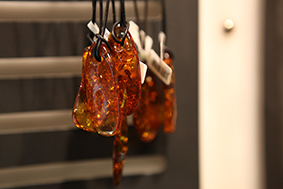
An amber chain, laid around the neck of a baby, makes the dentition easier for the child and takes pains from it. Amber supposedly unfolds an anti-inflammatory effect.
It is more likely that amber makes a good teething ring , because of its texture, if the baby takes the chain in the mouth.
Also „an aura from positive oscillations“ which goes out from the amber is mentioned in the stone medicine.
back
Amber room The most famous art object from amber was the amber room. In the 18th century the Prussian king Friedrich I. ordered the amber room for his Charlottenburger castle in Berlin, which was finished in 1712.
In 1716 his son gave away the room to Russian czar Peter I.
Later it was build into in the Katharinenpalast near St. Petersburg, during the Second World War it was robbed by the Germans and was brought to „Königsberg“. Since 1945 it is missing. Whether it burnt or was preserved, is unsettled. However, there are rumours after which the amber room should be still stored in subterranean tunnels.
In the years from 1979 to 2003 Russian specialists have reconstructed the amber room accessible to the public again, in the Katharinenpalast near Pushkin after unknown photographs had been found which allowed this unique project.

Rekonstruiertes Bernsteinzimmer
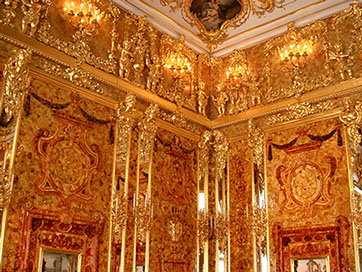
back
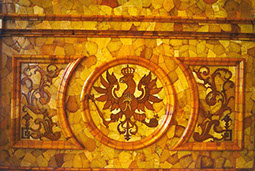
Characteristics The biggest up to now known amber piece was discovered in 1991 within the scope of a research expedition in Zentral-Sarawak (Indonesia). It weighed about 68 kg in the origin state and covered a surface of 5 m ². Nevertheless, only several sections could be rescued . The two biggest pieces with a total weight of about 23 kg can be found in the state museum for natural history in Stuttgart which is also in the possession of a Guinness book document (1995) for the biggest amber finding
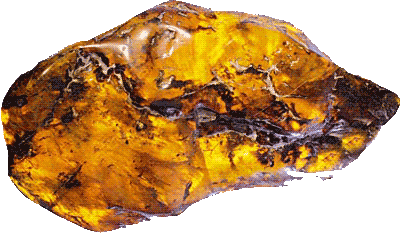
back
The Greek myth In the Bronze Age people pursued active trade in Europe. Namely with a raw material whose origin the Greeks explained by mythological stories: Phaethon, son of the sun-god Helios, borrows the solar carriage of his father, to „cruise“ around the firmament .
The four „hourse powers“ put the young savage into a speed rush, he loses control of the carriage and gets of the roadway. The result of it are completely messed up star signs . In that plummet to earth the burning carriage also sets the Caucasus and Etna on fire.
Regions singe, towns burn. Also the fact that Libya is a desert, we owe Phaethons infernal ride who by now wishes never to have hold the reins.
The remorse comes to late. Zeus flings a flash after him, meets him and finishes the "end of the world" spectacle. Phaethon falls in the river Eridanos and his sisters, the Heliaden, cry bitter tears.
As accomplices it becomes their destiny and punishment to scrape their living as poplars. Their tears which bubble from the bark finally change, in the sunlight to a material which makes the foundation-stone for one of the most important roads of Europe – amber.
So much for the myth.
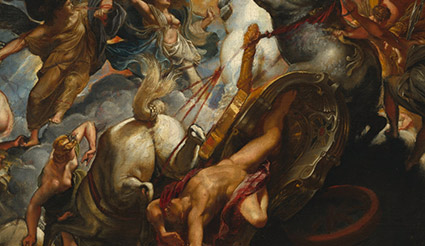
back

